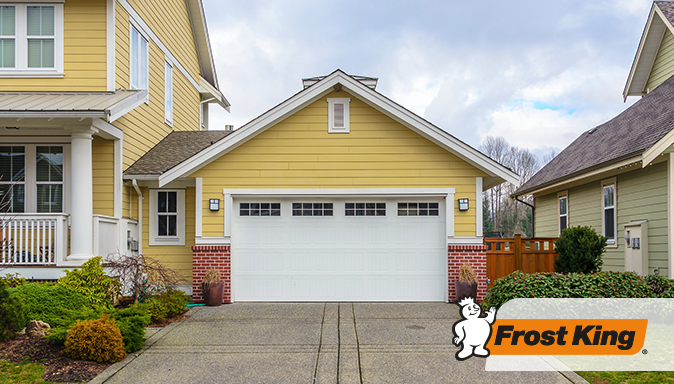If your home is like most, the front door gets all the glory… but it’s the garage door that does the heavy lifting.
You probably take it for granted that your garage door will quietly open and close with the touch of a button, keeping your cars and valuable items you store in your garage secure and protected. But according to Forbes, the average garage door opens and closes 1,500 times a year—that’s a conservative 4 times a day—putting a lot of strain and wear and tear on the primary entryway to your home.
The good news? Investing a little bit of time in some routine maintenance can keep your garage door working smoothly and reliably. We’ve put together a list of basic upkeep you can knock out in a weekend.
Before you get started, a word of caution: Unplug the garage door opener, and don’t make adjustments to the torsion spring mounted above the door or any bolts that are painted red: those are jobs for a trained professional.
Do a regular inspection
Addressing minor garage door issues promptly can prevent them from escalating into major problems. Start by visually inspecting your garage door and its components at least once a month. Look for signs of wear and tear, such as rust on the springs and tracks, cracks or dents in the door panels, and loose hardware. If you notice any issues, such as strange noises while the door is opening and closing, slow response times, or uneven movement, address them promptly. Ignoring these warning signs can lead to more significant problems and costly repairs down the line.
Replace worn weatherstripping
Maintenance is vital for safety, but it’s also important for energy efficiency and keeping out pests, too. Your door should have weatherstripping that seals the opening around the top, sides, and bottom of the door, but over time, this protective barrier can crack or become worn or damaged.
Check the weatherstripping periodically. If it’s in good shape, all you need to do is wipe it clean with an all-purpose cleaner and spray it with a silicone-based lubricant to keep it flexible. If it’s ripped or torn, you should replace it with new weatherseal. This video here explains how to properly install weatherstripping along the tops and sides of the garage door:
You also need to make sure the bottom seal that runs along the bottom of the door is in good shape; this is the long strip of rubber that’s attached to the bottom of the door and compresses when the door is closed to keep out dirt, water, drafts, and pests. The type of door bottom you use depends on what kind of door you have. Bottom seals on wood doors are nailed into place while metal doors have a channel that holds the door bottom in place; the seal is threaded into the channel and slides across the bottom of the door. Watch this video for step-by-step garage door bottom installation instructions:
Smooth operation
For your door to open and close smoothly with no squeaks, it’s crucial that moving parts are clean and well-lubricated. Periodically wipe down the inside of the tracks on either side of the door with a damp rag, then spray the rollers, hinges, tracks, and springs with a little bit of white lithium grease or silicone spray. Avoid using WD-40 or other oil-based lubricants, which attract dirt and debris and can drip onto your garage floor and make a mess.
Tighten the hardwar
Remember what we said about your garage door opening and closing 1,500 times a year? That’s a lot of movement and vibration that, over time, can loosen bolts and screws and throw your door out of alignment. Every few months, check all the hardware and tighten any loose screws, nuts, and bolts.
Test safety features
Modern garage doors are equipped with safety features to protect your family, guests, and pets from harm—but these features need to be tested regularly to make sure they’re working properly. Here’s how:
• Auto-reverse mechanisms cause the door to automatically reverse direction if it encounters any resistance while closing. To make sure it’s working properly, place a wooden block or another small object in the path of the closing door; the door should reverse immediately when it hits the block.
• Photoelectric sensors, located about six inches from the ground on either side of the track, work by emitting an invisible infrared beam across the door opening. If the beam is tripped by anything in its path—a person, a pet, or an object—the door will automatically stop moving. Over time, these sensors can become misaligned or obstructed by dirt, cobwebs, and other debris. Check to make sure the lenses are clean and adjust them if needed.
Check the balance
An unbalanced garage door can slam shut accidentally on anyone or anything in its path. This is why it’s important to test the door’s balance periodically. Start by opening and closing the door a few times, watching closely to see if the movements are slow or jerky. Next, unplug the garage door opener or turn off the circuit breaker, then pull on the manual release rope (look for a red handle) to detach the garage door from the opener. Manually raise the garage door to the halfway point and release it; if it stays in one place, it’s balanced. If it doesn’t, the door is out of balance; you should avoid using the door and call a garage door professional.
